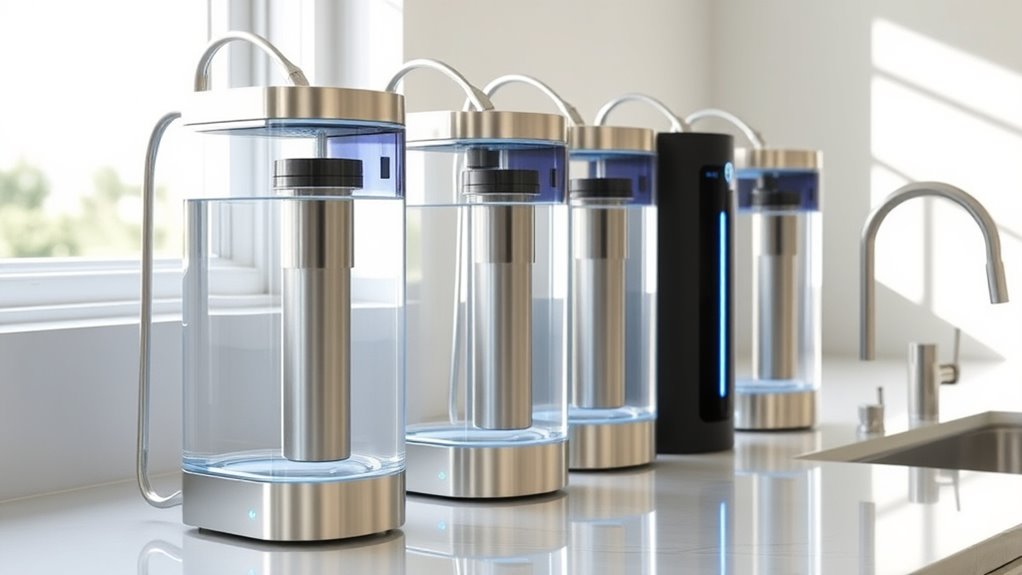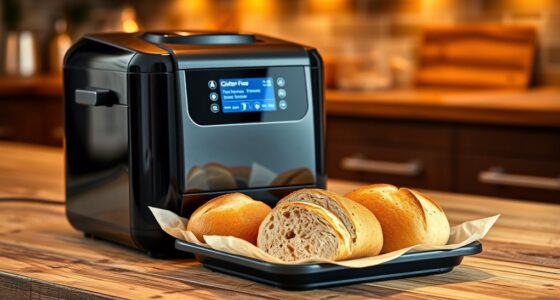Looking for the best water filtration systems in 2025? I’ve explored options like whole house filters, RO systems, and specialized units that effectively remove contaminants, improve taste, and protect your plumbing. From trusted brands like Aquasana and iSpring to advanced models with multi-stage filtration, there’s something for every budget and need. Keep scrolling to discover detailed reviews and insights that will help you choose the perfect system for clean, safe water.
Key Takeaways
- Whole house filtration systems like Aquasana EQ-1000 offer comprehensive water treatment for all household outlets.
- Reverse osmosis units such as iSpring RCC7AK and APEC ROES-50 provide high-purity drinking water by removing most contaminants.
- Specialized filters target specific pollutants like iron, lead, or PFAS, suitable for households with unique water quality issues.
- Modern systems feature easy installation, low maintenance, and smart indicators, making water filtration reliable and user-friendly.
- Consider budget, household size, and contaminant removal needs to choose the best filtration system for 2025.
HQUA WF3-01 3-Stage Whole House Water Filtration System
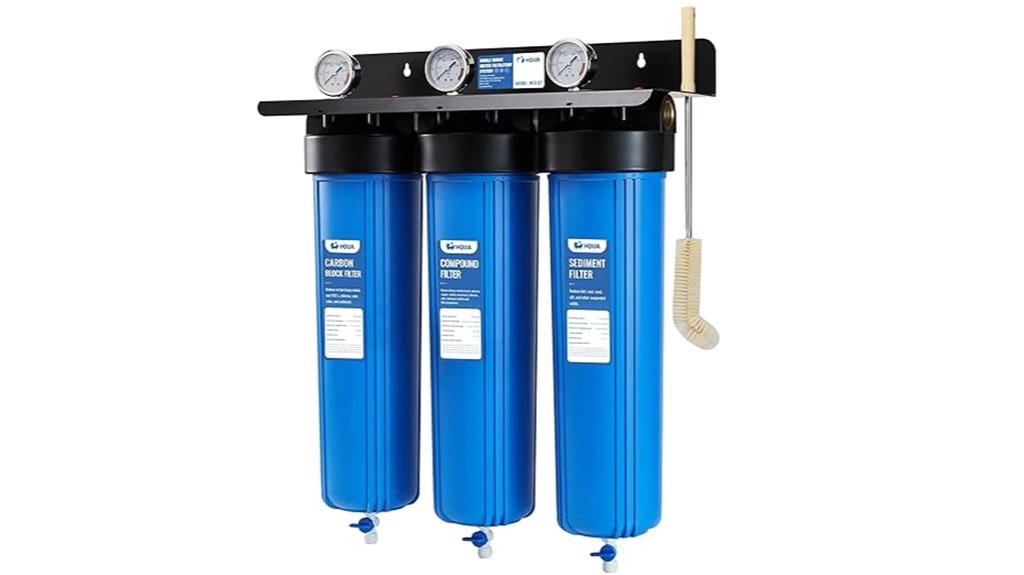
The HQUA WF3-01 3-Stage Whole House Water Filtration System is an excellent choice for homeowners who want thorough water purification throughout their entire house. It effectively reduces sediment, heavy metals, chemicals, and odors, improving water taste, clarity, and safety. The system features sediment and carbon block filters that remove dirt, rust, and suspended solids, while the GAC+KDF filter tackles lead, mercury, chloramine, and VOCs. With easy installation, multiple gauges, and maintenance tools included, it’s designed for reliable, long-lasting performance. This filtration system guarantees every tap in your home delivers cleaner, safer water, protecting your skin, hair, and overall health.
Best For: homeowners seeking comprehensive whole-house water filtration to improve water quality, safety, and taste throughout their entire home.
Pros:
- Effectively reduces sediment, heavy metals, chemicals, and odors for cleaner water.
- Includes multiple gauges and maintenance tools for easy monitoring and upkeep.
- Easy to install and maintain, ensuring long-lasting reliable performance.
Cons:
- No specific flow direction indicated, which may require additional attention during installation.
- Flow rate ranges from 3 to 15 GPM, which may be insufficient for very large households or high-demand scenarios.
- Larger size and multiple components may require adequate space and proper setup during installation.
Delta Faucet Clarifi Under Sink Reverse Osmosis System
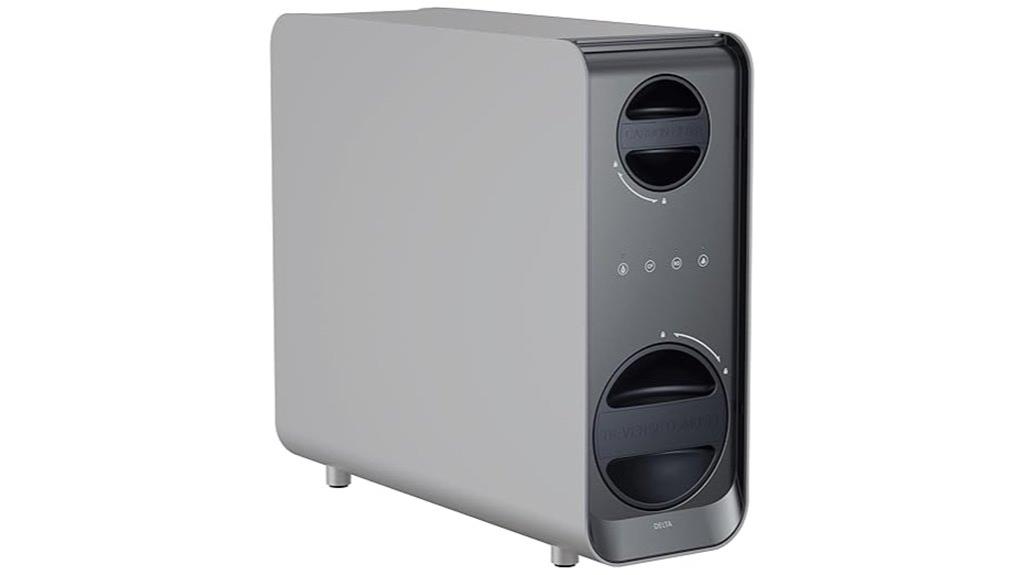
If you’re looking for a compact, highly effective water filtration system that fits under your sink, the Delta Faucet Clarifi Reverse Osmosis System is an excellent choice. It removes over 90 contaminants, including microplastics, lead, arsenic, PFAS, pharmaceuticals, and chemicals, thanks to its six-stage filtration process. Its tankless design saves over 60% of under-sink space, and it uses half the water of traditional systems, with easy DIY installation. Filters last about two years, and maintenance is quick. Certified by ANSI and NSF standards, it delivers clean, great-tasting water, making it a reliable, space-saving solution for healthier home drinking water.
Best For: Homeowners seeking a compact, efficient, and highly effective under-sink water filtration system that removes a wide range of contaminants and saves space.
Pros:
- Removes over 90 contaminants, including microplastics, lead, arsenic, PFAS, and pharmaceuticals, ensuring safer drinking water.
- Tankless design saves over 60% under-sink space and uses half the water compared to traditional systems.
- Certified by ANSI and NSF standards, with long-lasting filters and easy DIY installation for convenient maintenance.
Cons:
- Not included with an RO faucet, requiring an additional purchase for optimal setup.
- Notable noise during operation, resembling a small air compressor, which may be distracting.
- Occasional system alerts or shutdowns reported by users, potentially requiring troubleshooting or adjustments.
iSpring Iron, Hydrogen Sulfide & Whole House Water Filter System
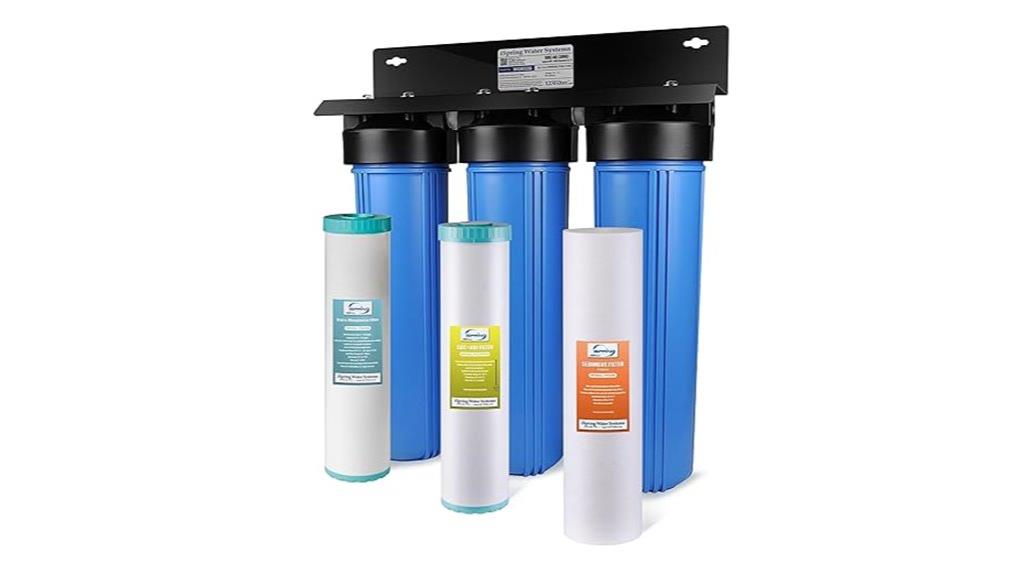
For households seeking thorough removal of iron, hydrogen sulfide, and other contaminants, the iSpring Iron, Hydrogen Sulfide & Whole House Water Filter System stands out as an ideal choice. Its advanced multi-stage filtration employs a sediment filter, a compound filter targeting chlorine, chloramine, heavy metals, and PFAS, plus an iron filter that reduces iron and manganese levels. It delivers up to 15 GPM, suitable for a family of four, with filters lasting about a year. Easy to install and maintain, it comes with detailed guides and support. This system preserves essential minerals since it doesn’t lower TDS, making it a reliable, long-term solution for clean, safe household water.
Best For: households needing comprehensive removal of iron, hydrogen sulfide, heavy metals, and other contaminants while preserving essential minerals in their water.
Pros:
- Multi-stage filtration effectively removes iron, hydrogen sulfide, lead, mercury, chloramine, PFAS, and heavy metals
- High flow rate of up to 15 GPM suitable for families of four with minimal pressure drop
- Easy DIY installation with detailed manuals and support, plus long-lasting filters (about one year)
Cons:
- Does not reduce Total Dissolved Solids (TDS), so essential minerals are preserved but may not address all mineral-related concerns
- Replacement filters need periodic maintenance, approximately annually, depending on water quality
- Does not include reverse osmosis, so it won’t significantly lower TDS levels or remove dissolved salts and certain contaminants
VIOMI 4-Year RO Water Filtration System with 9-Stage Reverse Osmosis, 600GPD, NSF/ANSI Certified

Looking for a reliable water filtration system that offers high-quality purification and long-term savings? The VIOMI 4-Year RO Water Filtration System is an excellent choice. It’s NSF/ANSI certified and reduces TDS by up to 94.75%, removing harmful substances like lead, fluoride, arsenic, and heavy metals. With a 9-stage filtration process and advanced 0.0001 μm membrane, it ensures pure, Odor-free water at a flow rate of 600 GPD. Its space-saving, tankless design makes installation easy, and filters last up to four years. Plus, the smart LED indicates when replacements are needed. This system combines efficiency, durability, and eco-friendliness for worry-free, high-quality drinking water.
Best For: households seeking long-term, high-quality water purification with eco-friendly and space-saving features.
Pros:
- Certified by NSF/ANSI and SGS, ensuring reliable filtration standards.
- 9-stage advanced filtration with a high flow rate of 600 GPD, providing quick access to pure water.
- Long-lasting filters that only need replacement every 2 to 4 years, reducing maintenance hassle.
Cons:
- Requires electrical outlet and drilling for installation, which may not be suitable for all spaces.
- Initial setup may take up to 20 minutes, potentially challenging for those uncomfortable with DIY tasks.
- The system’s size, while compact, still needs sufficient under-sink space and proper measurement before installation.
Whole House Water Filter System
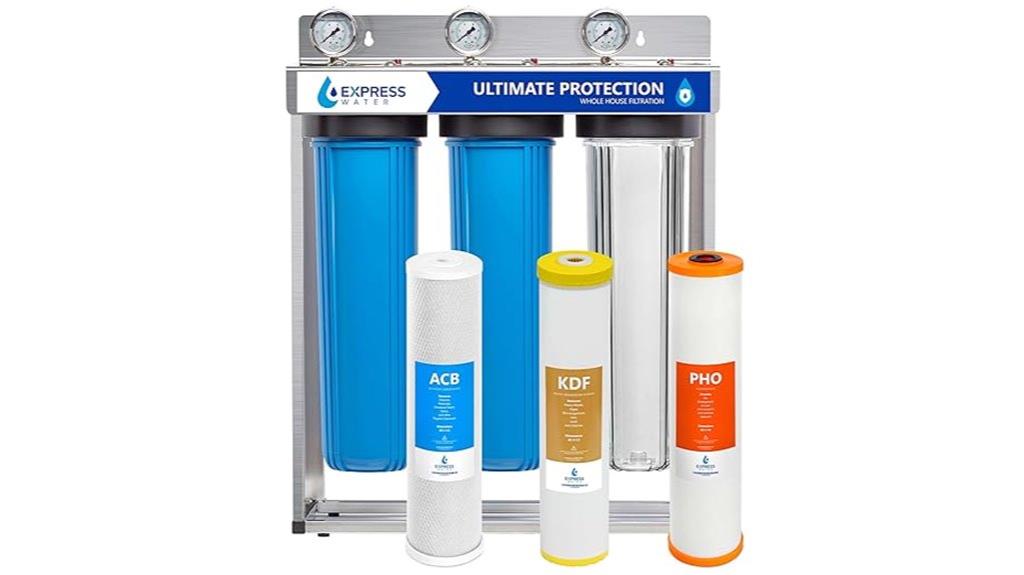
A Whole House Water Filter System offers thorough protection for households seeking to improve water quality from every tap. I’ve installed systems like the Ultimate Protection 3-stage filter, which reduces chlorine, heavy metals, chloramine, and other contaminants. It prevents scale buildup, protects pipes and appliances, and enhances water taste. The system is easy to install with durable stainless steel brackets, pressure gauges, and release buttons. Regular filter changes—every 6-12 months—keep it running smoothly. While it doesn’t lower TDS, it provides safe, clean water for drinking, cooking, and appliances. Overall, it’s a reliable, cost-effective solution for comprehensive household water treatment.
Best For: households seeking comprehensive whole-house water treatment to remove contaminants, improve water taste, and protect plumbing and appliances.
Pros:
- Effectively reduces chlorine, heavy metals, chloramine, and scale-causing substances.
- Easy to install with durable components like stainless steel brackets and pressure gauges.
- Low maintenance with affordable filter replacements every 6-12 months.
Cons:
- Does not reduce TDS levels; not suitable for mineral or pure water needs.
- Installation can be heavy and may require proper sealing and fittings for leak-free operation.
- Initial setup cost (around $750-$800) can be significant, especially with professional installation.
iSpring RCC7AK 6-Stage Reverse Osmosis System with Alkaline Remineralization

If you want a reliable water filtration system that combines thorough contaminant removal with mineral enhancement, the iSpring RCC7AK 6-Stage Reverse Osmosis System is an excellent choice. It’s easy to install thanks to its patented top-mounted fastener, which allows for quick setup without under-sink tightening. Certified by NSF/ANSI standards, it effectively reduces TDS, PFAS, chlorine, asbestos, heavy metals, and fluoride. The patent-pending AK stage adds natural minerals, balancing pH and improving water taste. With a 75 GPD capacity and lifetime support from a trusted brand, it’s a smart, hassle-free solution for clean, healthy water in your home.
Best For: households seeking a reliable, easy-to-install reverse osmosis system that effectively removes contaminants while adding beneficial minerals for better water taste and health.
Pros:
- Easy DIY installation with patented top-mounted fastener and clear instructions
- NSF/ANSI certified for rigorous contaminant removal, including heavy metals, fluoride, and PFAS
- Mineral enhancement with the patent-pending AK stage that balances pH and improves taste
Cons:
- Replacement filters may need frequent changing (every 6 months to 3 years) depending on usage
- Slightly higher initial cost compared to basic RO systems with no remineralization stage
- Capacity of 75 GPD might be insufficient for very large households with high water demand
APEC Water Systems ROES-50 Reverse Osmosis Water Filter System
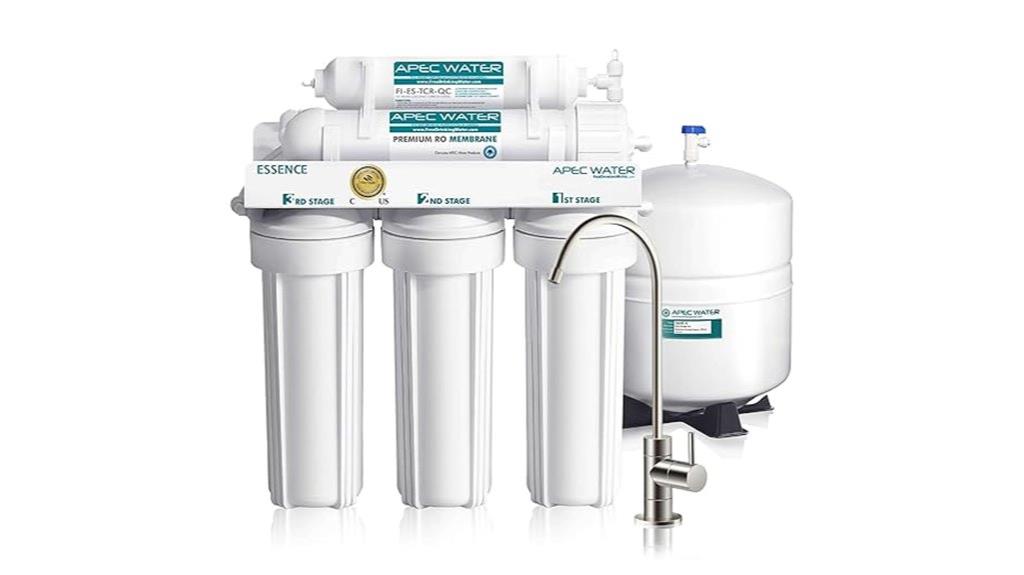
The APEC Water Systems ROES-50 Reverse Osmosis Water Filter System is ideal for those seeking high-quality, certified filtration that removes up to 99% of contaminants. This 5-stage system, designed and assembled in the USA, is WQA Certified for safety and quality. It effectively eliminates arsenic, chlorine, lead, fluoride, heavy metals, and over 1,000 other impurities, delivering crisp, clean water. With durable filters and a reliable design, it handles a maximum TDS of 2000 ppm and operates smoothly within standard water pressures. Includes a lead-free faucet and certified components, making it a dependable, safe choice for pure drinking water in any home.
Best For: households seeking reliable, high-quality water filtration with certified purity and removal of common contaminants.
Pros:
- Removes up to 99% of impurities including arsenic, lead, fluoride, and heavy metals
- WQA Certified for safety and quality assurance
- Durable, long-lasting filters and components for reliable performance
Cons:
- Installation may require some basic plumbing knowledge or professional help
- Replacement filters and parts can be relatively expensive over time
- Limited TDS handling capacity to a maximum of 2000 ppm
iSpring Whole House Water Filter System
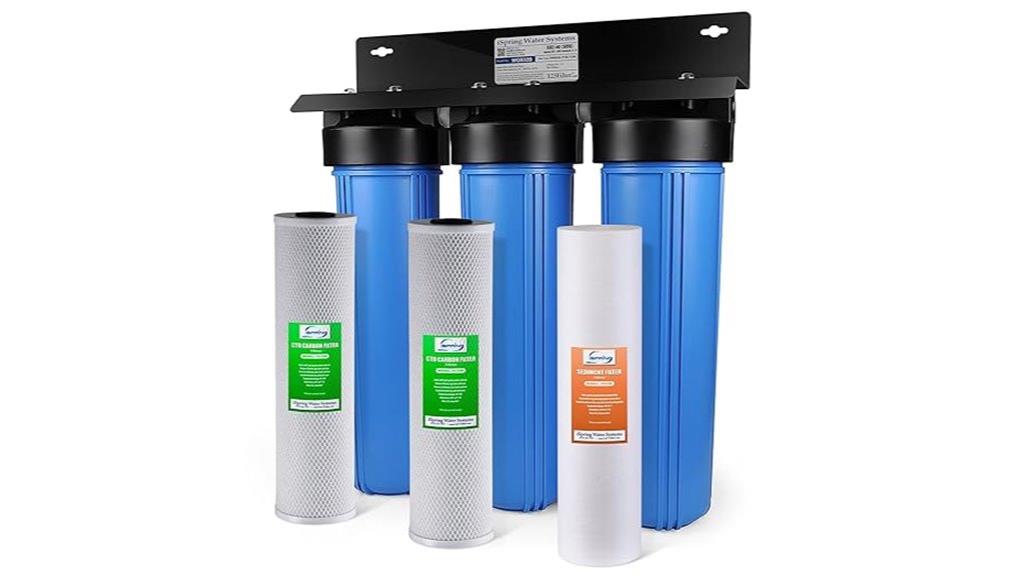
For homeowners seeking reliable, whole-house filtration, the iSpring WGB32B stands out with its extensive 3-stage system that reduces up to 99% of chlorine, sediments, rust, and odors. It features large 20-inch sediment and carbon block filters, including a 5-micron sediment filter and coconut shell carbon CTO filters, ensuring thorough contaminant removal. The system maintains healthy minerals, is TDS-friendly, and offers a capacity of 100,000 gallons, making it ideal for long-term use. Easy to install with clear instructions and YouTube guides, it also simplifies maintenance with replaceable cartridges and a spin-down sediment filter for routine flushing.
Best For: homeowners seeking comprehensive, reliable whole-house water filtration that effectively reduces contaminants and maintains water quality over the long term.
Pros:
- Provides up to 99% reduction of chlorine, sediments, rust, and odors for cleaner, better-tasting water
- Easy DIY installation with clear instructions and YouTube guides, plus simple cartridge replacement and maintenance
- Long-lasting capacity of 100,000 gallons, suitable for large households and outdoor installations in hot climates
Cons:
- Requires regular filter replacements and sediment flushing to maintain optimal performance
- May need precautions for outdoor installation to prevent plastic leaching in high temperatures
- Initial setup and understanding of system components may be challenging for complete beginners
HQUA WF3-01 3-Stage Whole House Water Filtration System
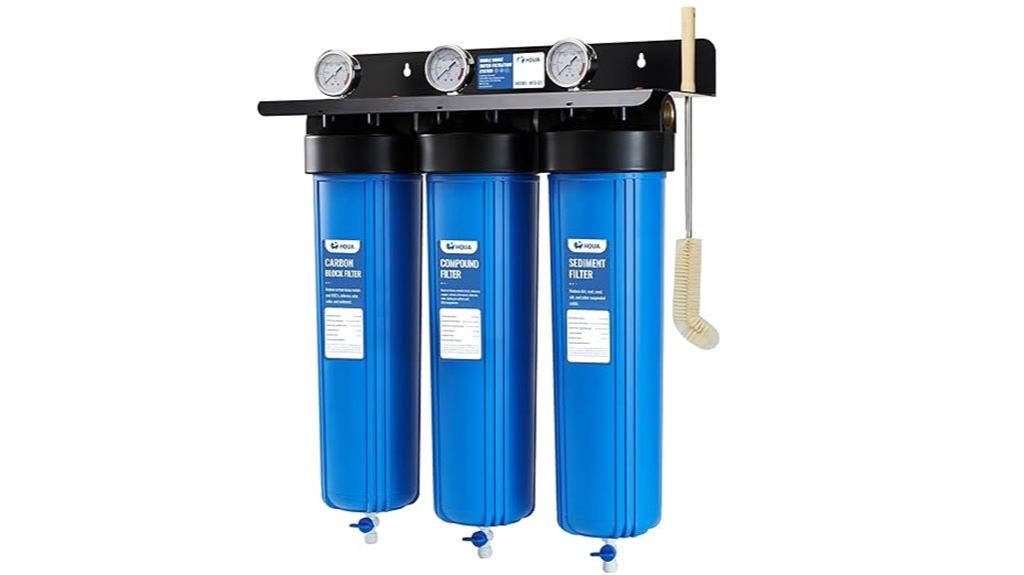
Looking to guarantee your entire household has access to clean, safe water? The HQUA WF3-01 3-Stage Whole House Water Filtration System is a great choice. It reduces sediment, heavy metals like lead and mercury, and chemicals such as chloramine and VOCs, improving water taste, clarity, and safety. The system features sediment and carbon block filters, along with a GAC+KDF filter for enhanced contaminant removal. Easy to install and maintain, it includes pressure gauges, timers, drain valves, and a cleaning brush. With a flow rate of up to 15 GPM, it ensures your whole home benefits from cleaner, healthier water daily.
Best For: households seeking comprehensive, whole-house water filtration to improve water quality, taste, and safety by reducing sediment, heavy metals, and chemicals.
Pros:
- Effectively removes sediment, heavy metals, and chemicals to enhance water purity
- Includes multiple monitoring and maintenance tools like pressure gauges and timers for easy upkeep
- High flow rate of up to 15 GPM supports whole-house use without sacrificing water pressure
Cons:
- No specific flow direction indicated, which may require careful installation
- Might be more complex or costly compared to point-of-use filters for smaller households
- Regular maintenance is necessary to ensure optimal performance and longevity
iSpring WGB21B 2-Stage Whole House Water Filtration System

If you’re seeking an effective whole house filtration solution that balances performance and affordability, the iSpring WGB21B 2-Stage System is an excellent choice. It filters up to 50,000 gallons annually, making it ideal for a family of four. The first stage captures sediment, dirt, and rust, while the second reduces chlorine, bad tastes, odors, and VOCs, without removing beneficial minerals. Easy to install with a compact design, it offers a flow rate of 15 GPM and straightforward filter replacements. Many users praise its ability to improve water clarity and taste, along with responsive customer support. It’s a reliable, cost-effective way to enjoy cleaner, healthier water throughout your home.
Best For: families or households seeking an affordable, reliable whole house water filtration system that effectively removes sediments, chlorine, and odors without reducing beneficial minerals.
Pros:
- Easy DIY installation with pre-assembled components and included tools
- High flow rate of 15 GPM suitable for whole house use
- Improves water taste, clarity, and appliance longevity with minimal maintenance
Cons:
- Some users may experience minor leaks or pinholes requiring repairs
- Does not reduce TDS or retain specific minerals like reverse osmosis systems
- Filter lifespan depends on water quality, potentially requiring more frequent replacements in very dirty water
Whole Home Water Filtration System
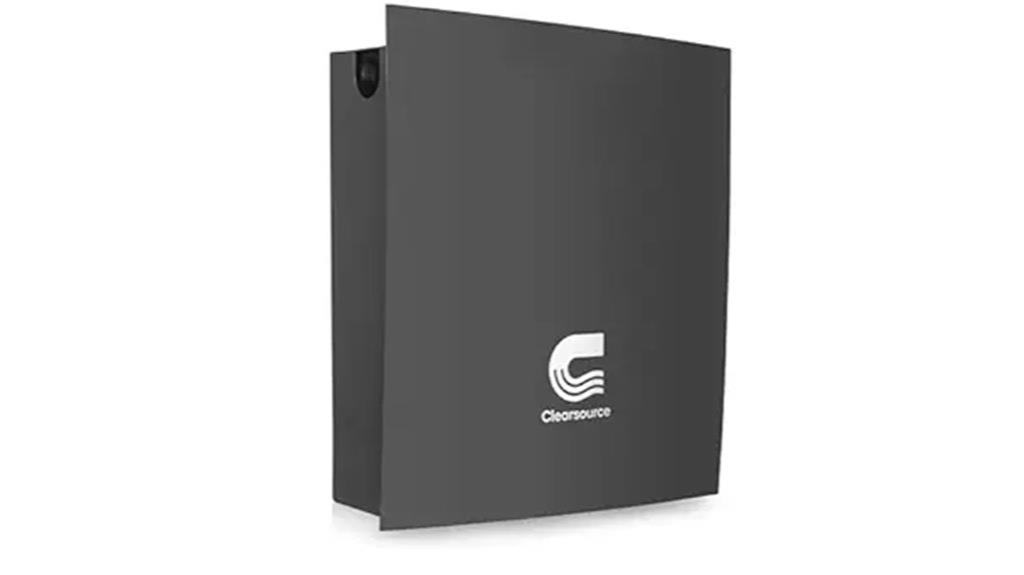
A Whole Home Water Filtration System is an excellent choice for homeowners who want thorough protection against a wide range of contaminants. The Clearsource system offers extensive filtration, improving water taste and smell throughout your house. Its compact, durable design fits easily into your space, with premium components that last. It uses a three-stage process: a sediment filter, a coconut shell carbon block for chlorine and VOC removal, and VirusGuard technology that captures viruses, bacteria, and chemicals. Installation takes about two hours and doesn’t affect water pressure. With superior protection and long-term reliability, this system ensures safe, clean water for drinking, bathing, and cooking.
Best For: homeowners seeking comprehensive, long-lasting water filtration that effectively removes viruses, bacteria, chemicals, and improves overall water quality throughout their entire house.
Pros:
- Industry-leading VirusGuard technology provides superior protection against viruses, bacteria, and contaminants.
- Multi-stage filtration system effectively improves water taste, smell, and safety for all household uses.
- Compact, durable design with premium components ensures space-saving installation and long-term reliability.
Cons:
- Professional installation is recommended, which may incur additional costs.
- The initial setup process, though quick, requires time and proper placement considerations.
- Higher upfront investment compared to basic or point-of-use filters.
Whole House Water Filter System
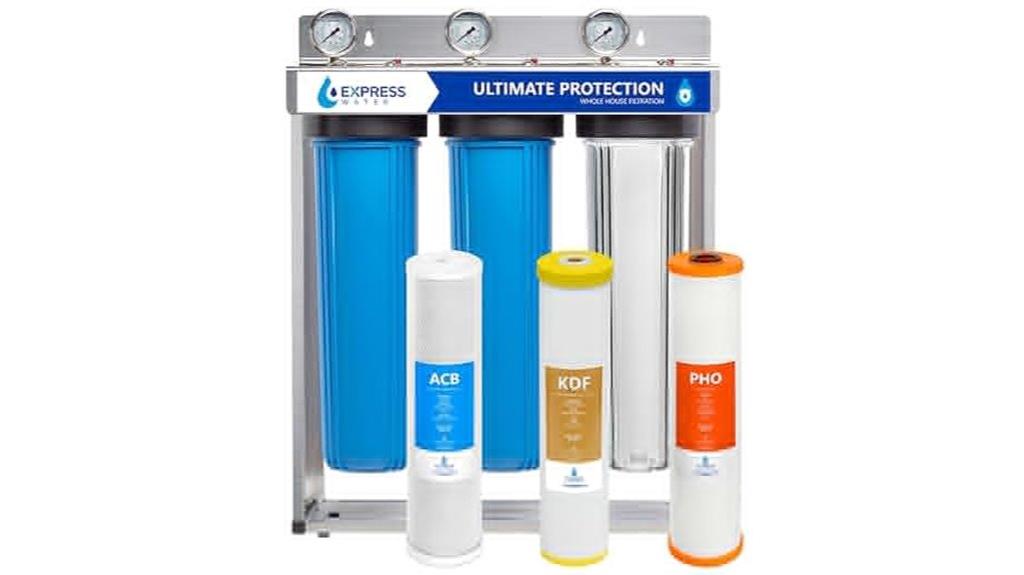
The Whole House Water Filter System is an ideal choice for homeowners who want extensive protection against common water contaminants. It provides thorough filtration for every faucet, effectively reducing chlorine, heavy metals like lead and mercury, chloramine, and other pollutants. Designed to prevent scale buildup and protect pipes and appliances, it also improves water taste and clarity. Easy to install with a sturdy stainless steel bracket, pressure gauges, and release buttons, it’s a reliable, low-maintenance solution. Regular filter replacements every 6-12 months keep performance prime, making it a cost-effective way to ensure safe, high-quality water throughout your entire home.
Best For: homeowners seeking comprehensive, whole-house protection against common water contaminants, heavy metals, and scale buildup for improved water quality and appliance longevity.
Pros:
- Effectively reduces chlorine, heavy metals, chloramine, and other pollutants for cleaner, better-tasting water.
- Easy to install with durable stainless steel brackets, pressure gauges, and user-friendly features.
- Low-maintenance with filter replacements recommended every 6-12 months, ensuring consistent performance.
Cons:
- Does not lower TDS levels; reverse osmosis systems are needed for that.
- Installation can be heavy and may require careful sealing and proper fittings to avoid leaks.
- Total initial setup cost can be around $750-$800, which may be high for some budgets.
Aquasana Whole House Water Filter System
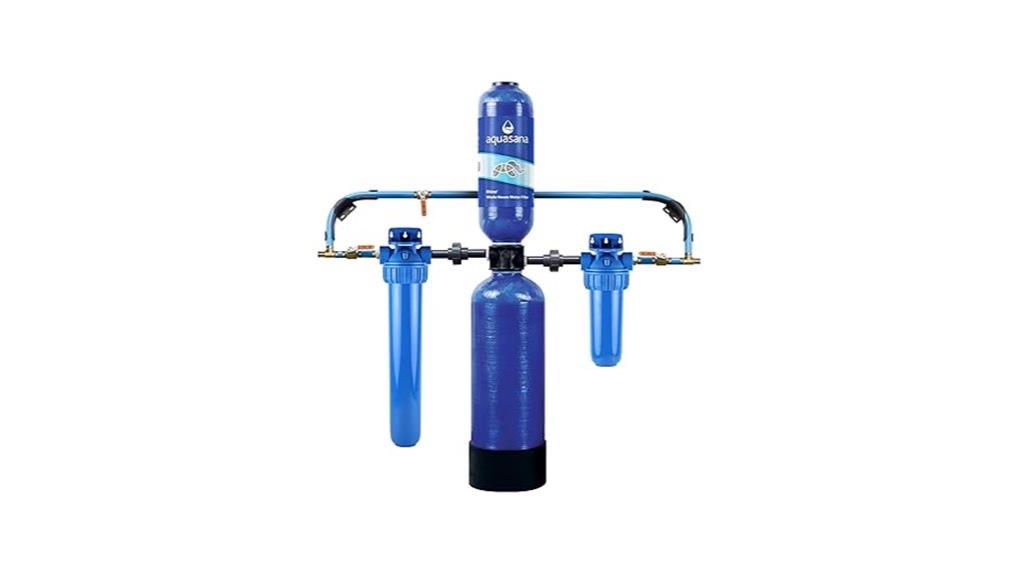
For homeowners seeking reliable, whole-house water purification, the Aquasana EQ-1000 system stands out thanks to its high-performance activated carbon and KDF filtration media. It reduces 97% of chlorine, ensuring better-tasting water from every tap while preserving essential minerals. The Rhinos-improved divider valve guarantees a strong flow rate with no pressure drops. Cost-efficient and long-lasting, it filters up to 1 million gallons or about 10 years, with minimal maintenance—just replacing pre- and post-filters every two months. Easy to install, this system provides consistent, high-quality water throughout your home without complex upkeep or significant expense.
Best For: homeowners seeking a reliable, long-lasting whole-house water filtration system that maintains mineral content and offers cost-effective, easy maintenance.
Pros:
- Effectively reduces 97% of chlorine, improving water taste and quality
- Provides high flow rate with no pressure drop thanks to Rhinos-improved divider valve
- Filters up to 1 million gallons or approximately 10 years, offering long-term savings
Cons:
- Pre- and post-filters need replacement every 2 months, requiring regular upkeep
- Components may ship separately, potentially complicating installation
- Does not reduce Total Dissolved Solids (TDS), so mineral content remains unchanged
Reverse Osmosis Water Filter System by DESENRUIS
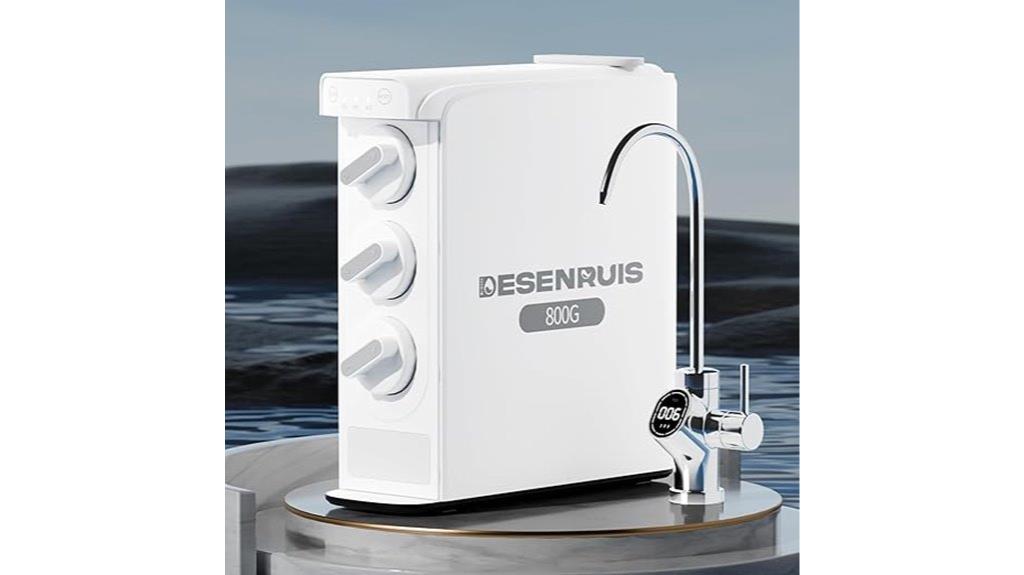
Seeking a high-capacity water filtration system that can keep up with a busy household? The DESENRUIS Reverse Osmosis Water Filter delivers impressive performance, removing 99.9999% of impurities like lead, fluoride, PFAS, and nitrates. Its dual membranes with 0.0001μm precision ensure efficiency and longevity, while the 800 GPD flow rate provides instant water, perfect for large families. The compact, tankless design saves space, and the 3:1 pure-to-drain ratio minimizes waste. Easy to install and maintain, it features a smart LED faucet for real-time monitoring. This system offers clean, great-tasting water comparable to bottled quality, making it a top choice for demanding households.
Best For: households requiring high-capacity, space-saving, and efficient reverse osmosis water filtration with easy maintenance.
Pros:
- Removes 99.9999% of impurities, including PFAS, fluoride, lead, and nitrates, ensuring high-quality drinking water.
- 800 GPD flow rate provides instant, plentiful water suitable for large families and high-demand use.
- Compact, tankless design saves up to 70% under-sink space and reduces water waste with a 3:1 pure-to-drain ratio.
Cons:
- Installation can be challenging, especially for saddle drain setup and tight under-sink spaces.
- Some users report difficulties with filter size information and long-term maintenance costs.
- May require additional parts (adapters, quick-connect fittings) for custom plumbing setups.
Express Water RO5DX Reverse Osmosis System with Faucet and Filters
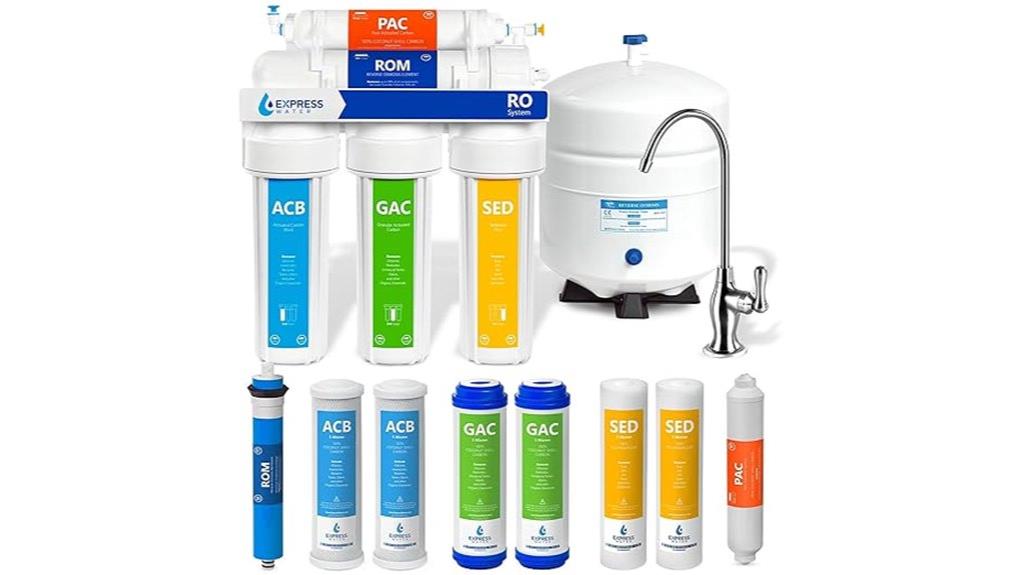
If you’re looking for an efficient under-sink water filtration system that offers high contaminant reduction, the Express Water RO5DX is an excellent choice. It’s NSF-certified and features a compact 5-stage reverse osmosis process that removes up to 99.99% of contaminants like lead, fluoride, arsenic, and PFAs. The system includes a 4-gallon tank, a fast-flow faucet, and all necessary filters, making installation straightforward—perfect for DIY setup. It operates on 40-80 PSI water pressure and can be enhanced with an optional permeate pump for better efficiency, reduced wastewater, and faster tank filling. Overall, it provides clean, great-tasting water with minimal fuss.
Best For: Homeowners, renters, and small offices seeking an easy-to-install, high-efficiency water filtration system that removes a wide range of contaminants for better-tasting water.
Pros:
- NSF-certified with up to 99.99% contaminant reduction for safe, clean water
- Compact, easy DIY installation with quick connect tubing and all necessary filters included
- Enhances water taste and quality, reducing reliance on bottled water
Cons:
- Installation instructions are somewhat generic and may require additional measuring or adjustments
- Filter replacements cost approximately $60 annually, which can add up over time
- Permeate pump, if added aftermarket, may produce noise and requires extra space for installation
Factors to Consider When Choosing Water Filtration Systems for Homes
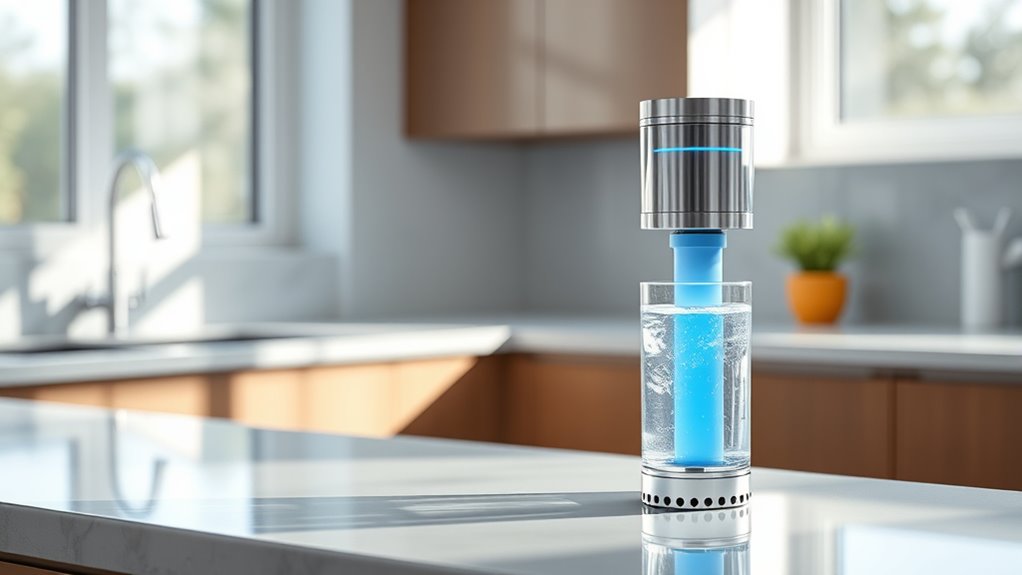
When choosing a water filtration system for my home, I focus on how well it removes contaminants and fits my space. I also consider how easy it is to install, maintain, and the ongoing filter costs. Ultimately, I look at water flow, pressure, and whether the system matches my home’s design.
Contaminant Removal Capabilities
Have you ever wondered how different water filtration systems target specific contaminants? Not all systems remove the same pollutants, so it’s essential to match your water quality issues with the right technology. For example, reverse osmosis systems can eliminate over 99% of impurities like fluoride, lead, arsenic, and PFAS, delivering highly purified water. Activated carbon filters excel at removing chlorine, chloramine, VOCs, and odors but might not handle dissolved inorganic contaminants. Some setups combine multiple stages, offering broader protection against a range of pollutants. To ensure your system does what it promises, look for certifications from organizations like NSF and ANSI. These verify the system’s ability to reduce specific contaminants according to industry standards, giving you confidence in your choice.
System Installation Ease
Choosing a water filtration system that’s easy to install can save you time and frustration. Look for units with clear, step-by-step instructions and minimal tools required—these are typically more DIY-friendly. Systems that use standardized fittings like quick-connect or compression fittings make connecting to your existing plumbing straightforward, without needing special tools. Modular components or pre-assembled parts also cut down installation time and complexity. Features like color-coded hoses, detailed diagrams, and online tutorials further simplify the process. Additionally, systems that require little to no drilling, no electrical connections, and are compatible with common pipe sizes tend to be the easiest to set up. Prioritizing these factors can make your installation smooth and hassle-free, getting clean water flowing quickly.
Maintenance and Filter Costs
Installing a water filtration system is just the first step; keeping it running smoothly requires regular maintenance and mindful budgeting. Most systems need filter replacements every 6 months to 2 years, depending on water quality and usage. The cost of filters varies widely, from about $12 to over $60 a year per filter, which can add up over time. Some advanced systems feature longer-lasting filters, such as four-year RO membranes, reducing replacement frequency and costs. To make an informed choice, consider the ongoing expenses and evaluate the cost per gallon of filtered water. Proper maintenance, including timely filter changes and system cleaning, not only guarantees peak performance but also prevents costly repairs or system failure down the line. Budgeting for these expenses is key to long-term affordability.
Space and Design Compatibility
When selecting a water filtration system, it’s vital to evaluate how well it will fit into your home’s available space and aesthetic. Consider the system’s dimensions to guarantee it comfortably fits under your sink or designated area without causing clutter. Space-saving designs like tankless or compact units can maximize efficiency while maintaining a clean look. Check if the installation options—wall-mounted or free-standing—align with your space and preferences. Also, assess the system’s weight and portability to determine ease of installation and whether additional support is needed. Finally, choose a design that complements your home’s decor, and verify the placement allows easy access for maintenance and filter replacements, making the entire process simple and hassle-free.
Water Flow and Pressure
Ensuring your water filtration system delivers enough water quickly and efficiently depends largely on its flow rate and pressure. A good flow rate for household needs is typically between 3-5 gallons per minute (GPM), ensuring you won’t experience delays or pressure drops during daily tasks. Water pressure, measured in PSI, also plays an essential role; most systems operate best between 40-80 PSI. If pressure drops below 40 PSI, flow slows, and you might need booster pumps to keep things moving smoothly. On the other hand, pressures above 80 PSI can damage filters and plumbing, so pressure regulation devices are crucial. Maintaining consistent water pressure helps optimize filtration performance, prevents system strain, and extends the lifespan of your unit.
Certification and Safety Standards
How can you be confident that a water filtration system is safe and effective? The answer lies in certification from reputable organizations like NSF, ANSI, or WQA. These certifications confirm the system meets strict safety and performance standards. NSF/ANSI labels indicate the system can reliably reduce contaminants like lead, chlorine, fluoride, and pathogens. WQA certification shows the product complies with high-quality manufacturing practices and safety regulations. Certified systems usually display labels or documentation proving their compliance, giving you peace of mind about their efficacy. Choosing certified filtration systems ensures your water is safe, free from harmful impurities, and aligns with health guidelines set by regulatory agencies. It’s a crucial step in selecting a reliable, effective water filtration solution for your home.
Frequently Asked Questions
How Often Should I Replace Filters in My Home Water System?
You’re wondering how often to replace filters in your home water system, and I get it—timing is key. I recommend checking your manufacturer’s guidelines, but generally, filters should be replaced every 6 to 12 months. Keep an eye on water flow and taste; if it drops or water smells odd, it’s time for a change. Regular replacements guarantee clean, healthy water and ideal system performance.
Can Water Filtration Systems Remove All Types of Contaminants?
Did you know that the EPA estimates over 90% of tap water in the US is safe to drink? However, no filtration system can remove every single contaminant. I’ve found that most systems effectively target common pollutants like chlorine, sediment, and lead, but some smaller or chemical contaminants may require specialized filters. It’s essential to choose a system tailored to your specific water issues for the best protection.
What Is the Maintenance Cost for Different Filtration Systems?
You’re wondering about maintenance costs for different filtration systems. I’ve found that systems like reverse osmosis can be pricier to maintain due to filter replacements every 6-12 months, costing around $100-$200 annually. Carbon filters are more affordable, typically costing $50-$100 yearly. While UV systems have minimal ongoing costs, they do require bulb replacements every year. Overall, maintenance varies, but budgeting around $50-$200 a year covers most systems comfortably.
Do Filtration Systems Improve Water Taste and Odor?
Absolutely, filtration systems can considerably improve water taste and odor. I’ve noticed that once I installed a good filter, my tap water tasted fresher and smelled cleaner. These systems remove chlorine, organic compounds, and other impurities that cause unpleasant tastes and smells. It’s a simple upgrade that makes drinking water more enjoyable and confident, knowing it’s cleaner and better tasting.
Are There Any Health Risks With Certain Filtration Technologies?
Oh, the irony is thick—some filtration tech can pose health risks? It’s true! While many filters remove harmful contaminants, certain cheap or outdated systems might introduce unwanted chemicals or bacteria. I always recommend researching and choosing reputable brands. After all, we trust our water to be safe, not to turn into a health gamble. Better safe than sorry, right? Filtering wisely is key to truly clean, healthy water.
Conclusion
Choosing the right water filtration system might seem overwhelming, but I promise it’s worth it for clean, great-tasting water. Even if you’re worried about the upfront cost or installation, remember that investing in your health saves money and hassle in the long run. With so many reliable options out there, you can find one that fits your needs and budget. Don’t wait—upgrade your home’s water today for peace of mind tomorrow.
